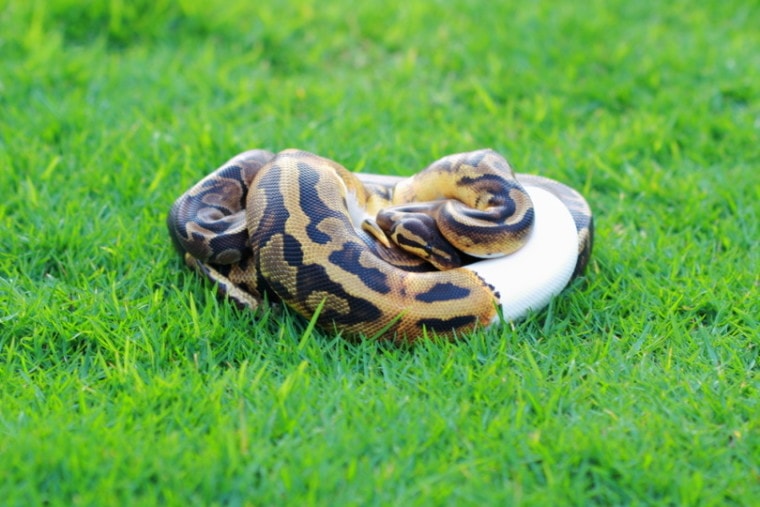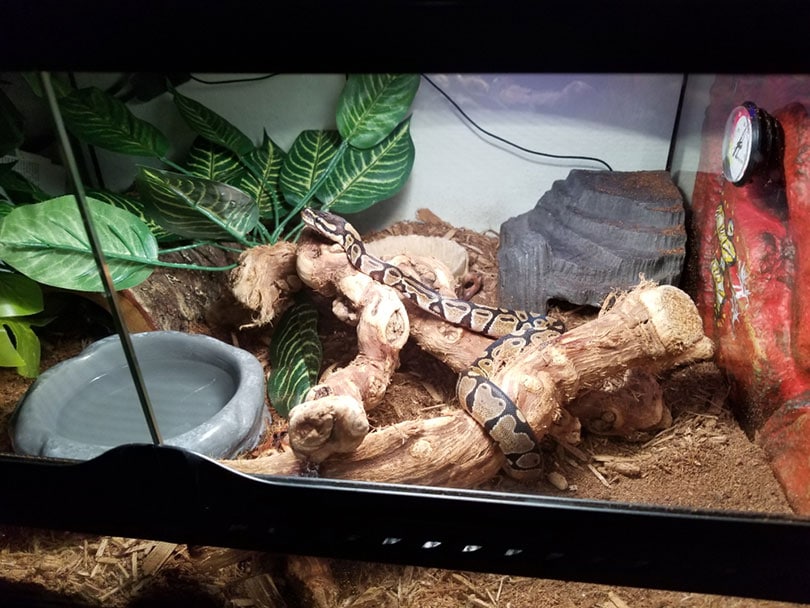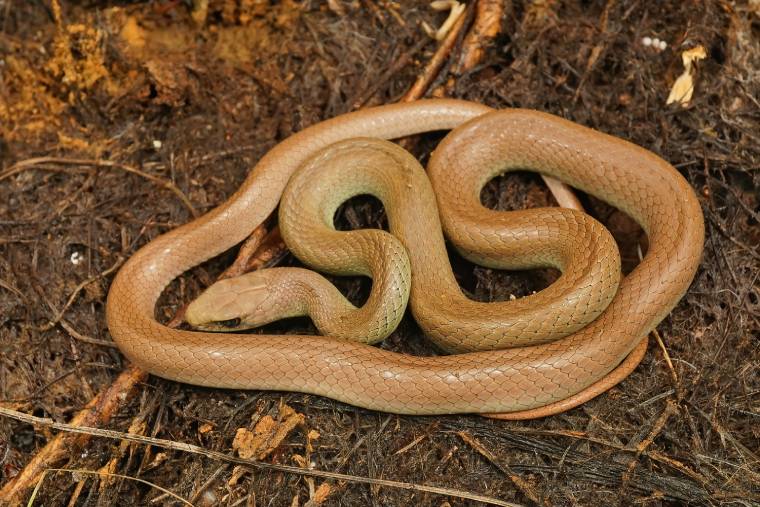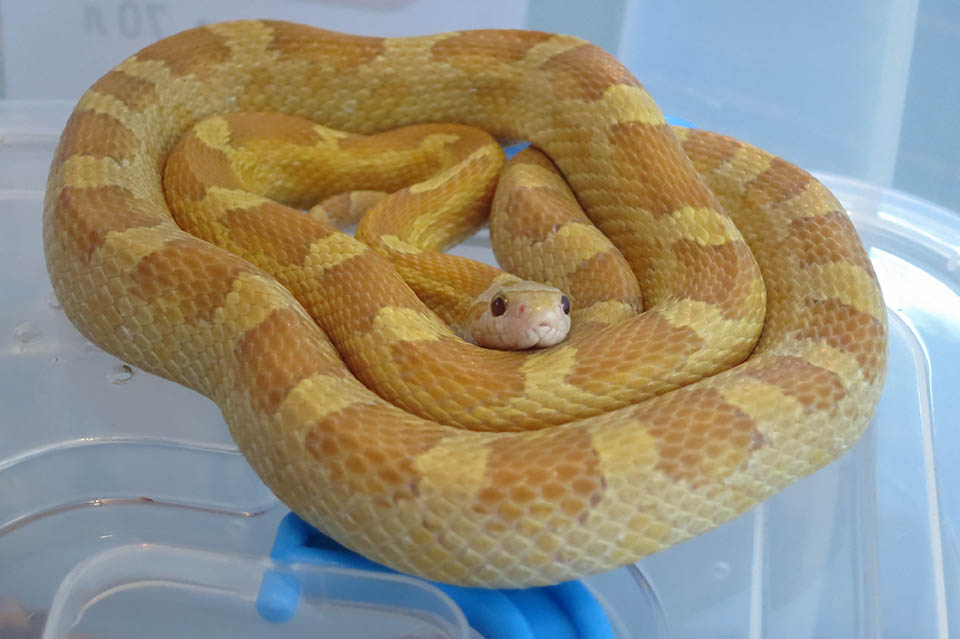
The GHI Ball Python morph is a relatively new morph, discovered in 2007 among a shipment of imports to Florida. GHI Ball Pythons have a very unique appearance that makes them look much darker than other morphs. Aside from their different morph, this Ball Python is still super easy to take care of.
If you are interested in GHI Ball Pythons, you have come to the right place. In this article, we are going to look at this specific morph, as well as how to care for the Ball Python as a pet. Let’s get started.
Quick Facts about GHI Ball Python Morph

| Species Name: | Python Regius |
| Common Name: | Ball Python |
| Care Level: | Beginner |
| Lifespan: | Up to 30 years in captivity |
| Adult Size: | 4-5 feet long |
| Diet: | Carnivore, small rodents |
| Minimum Tank Size: | 40 L |
| Temperature & Humidity: | Temperature: 75-95 degrees Fahrenheit Humidity: 40%-60% |
Do GHI Ball Python Morph Make Good Pets?
GHI Ball Pythons can make good pets if you can get your hands on one.
Just like other Ball Pythons, GHI Ball Pythons make good pets in terms of requirements and temperament. They are easy to care for and are pretty passive.
However, this morph is more difficult to find. As a result, you might want to go with a different morph if you want one that is a bit more convenient or affordable. However, if you are willing to put in the time and money required to find a GHI morph, it makes a great pet.
Appearance
The GHI morph is very impressive. Its pattern is similar to a wild Ball Python, but the background color is nearly black. The lighter pattern is darker than regular snakes too, but it is the jet-black background that really makes the GHI morph stand out.
Since their discovery in 2007, GHI Ball Pythons morphs have created gorgeous snakes. Some are so dark that they almost look satin like. The look is definitely intimidating, despite their gentler demeanor.

How to Take Care of GHI Ball Python Morph
Ball Pythons are considered relatively easy to take care of in comparison to other reptiles, and the same goes for GHI Ball Pythons. You would care for a GHI Ball Python just as you would any other morph.
Habitat, Tank Conditions & Setup
Tank
You need to get a 40-gallon tank for your Ball Python. However, the bigger the better. The tank can either be made of glass or plastic. Keep in mind that plastic will retain more humidity, but glass will be prettier to look at. It is up to you which one you should get.
Inside the tank, you should place a branch for the snake to climb on. You should also provide a hiding area. It’s a good idea to place a tube that runs from the cool end to the hot end so that there is a hiding area in both temperatures.
You’ll need to deep clean the tank with reptile safe cleaner once a month. In between the cleanings, spot clean the tank every day or every other day at the least.
Lighting
Ball Pythons do not require as extensive lighting requirements. You only have to replicate the natural day and night cycle. Have 8 to 12 hours of light. You can set the tank close enough to a window so that it gets natural sun.
If you have a glass container, be cautious with this method because setting the container right next to a window can cause the inside to get too hot. During the night, use a nocturnal or infrared light.

Heating (Temperature & Humidity)
You will need to provide a temperature gradient inside the enclosure. This means there should be a warm side and a cool side of the tank. The warm side should be about 95 degrees Fahrenheit, and the cool end should be about 78 degrees Fahrenheit.
Additionally, make sure that the enclosure has humidity levels between 40% and 60%. Whenever your Ball Python is shedding, increase the humidity just slightly.
Substrate
Substrate is the stuff that you put at the bottom of the enclosure. Aspen shavings are ideal, but you can use coconut fiber bedding or reptile bark instead. Do not use sand or rocks.
Tank Recommendations
| Tank Type: | 40-gallon vivarium |
| Lighting: | Regular day/night cycle Infrared light at night |
| Heating: | Temperature gradient |
| Best Substrate:: | Aspen bedding |

Feeding Your GHI Ball Python Morph
GHI Ball Pythons should be fed a diet of rodents only. Although you can feed live rodents to the snake, we recommend pre-killed rodents that have been thawed and then warmed up. Pre-killed rodents do not pose as much of a risk of injury to the snake.
Feed your Ball Python once a week if it is a juvenile and every one to two weeks if it is an adult. You should place the snake in a separate tank during feeding so that the Ball Python does not strike every time you open the lid. Because Ball Pythons are nocturnal, we recommend feeding them at night.
Diet Summary
| Meat: | 100% of diet – small/medium sized rodents; pre-killed recommended |
| Supplements Required: | N/A |
Keeping Your GHI Ball Python Morph Healthy
Ball Pythons are hardy creatures. With proper diet and maintenance, these creatures can live up to 30 years. It’s most important to keep the enclosure suitable for snakes at all times. This includes keeping it clean, warm, and humid.
You can make sure that your GHI Ball Python is healthy by paying attention to its mannerisms. If your snake is active, has clear eyes, and eats regularly, it is likely healthy. Signs of illness include infrequent shedding, vomiting, lethargy, and decrease in appetite.

Common Health Issues
Lifespan
If you get a GHI Ball Python, know that you’re making a long-term commitment. These snakes can live up to 30 years with proper care. Some Ball Pythons have been known to live longer, but this is rare.
Luckily, you should be able to take your GHI Ball Python with you to most locations. Most apartments and condominiums allow Ball Pythons since they are small and not dangerous.
Breeding
Breeding regular Ball Pythons can be a bit difficult. Breeding GHI Ball Pythons is next to impossible. You have to have a lot of patience, time, and technical genetic skills to breed this unique morph.
To begin, you’ll have to replicate the snake’s native environment during the breeding season. From there, you have to select parent snakes that have the possibility to produce GHI snakes. Even with this care, the snakes may still not mate.
Are GHI Ball Python Morphs Friendly? Our Handling Advice
Ball Pythons are a bit shy, which means they will be reluctant at first to be handled. Expect your Ball Python to hide from you initially. As you start to establish trust with your snake, the Ball Python should start to allow you to handle it more and more.
Some Ball Pythons are even known to enjoy being handled once trust is established. Remember to be gentle with the Ball Python and avoid fast movements. Try to provide as much support to the snake’s body as well.
Do not handle Ball Pythons before or after you intend to feed it. Similarly, do not handle Ball Pythons whenever they are shedding.

Shedding & Brumation: What to Expect
All snakes, including Ball Pythons, shed their skin as they grow. Adolescent Ball Pythons will shed more frequently because they are growing faster. Whenever your snake is shedding, try not to touch it or feed it anything. Instead, increase the humidity and let it be.
You don’t have to expect a lot for brumation. Ball Pythons do not technically brumate, but they may decrease their appetite during the winter months. Do not be alarmed if your snake starts to eat less when it is cooler outside.
How Much Do GHI Ball Python Morphs Cost?
Because it is so easy to find Ball Pythons, they are relatively affordable. You can find some Ball Python morphs for about $50. GHI morphs, however, are more expensive. In fact, GHI Ball Pythons are some of the most expensive morphs.
You should expect to pay around $3000 for a GHI Ball Python. This does not even include the habitat necessities or food.
Care Guide Summary
Final Thoughts
GHI Ball Pythons really are one of a kind. Their unique morph pattern makes them look striking and a bit frightening, but they have passive personalities that make them great pets. Not to mention, they are just as easy to care for as any other Ball Python.
The biggest downside of GHI Ball Pythons is their price. It is incredibly difficult to breed these snakes. So, they are hard to find for sale. When you do find one, expect to pay thousands of dollars.
Featured Image Credit: Lamnoi Manas, Shutterstock






